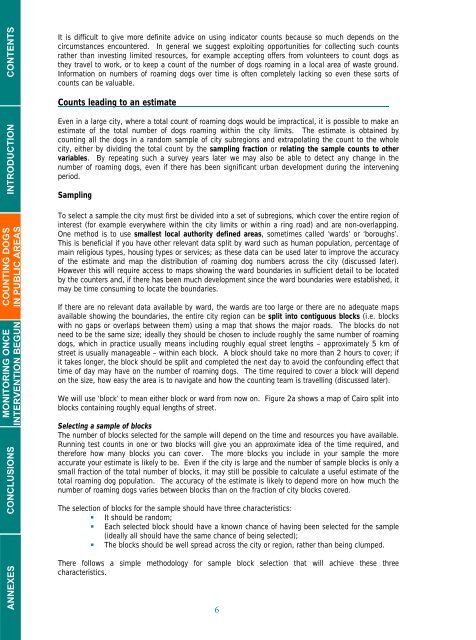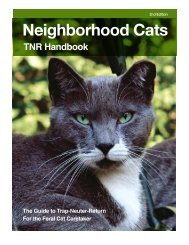Surveying roaming dog populations: guidelines ... - Animal Sheltering
Surveying roaming dog populations: guidelines ... - Animal Sheltering
Surveying roaming dog populations: guidelines ... - Animal Sheltering
Create successful ePaper yourself
Turn your PDF publications into a flip-book with our unique Google optimized e-Paper software.
CONTENTS<br />
It is difficult to give more definite advice on using indicator counts because so much depends on the<br />
circumstances encountered. In general we suggest exploiting opportunities for collecting such counts<br />
rather than investing limited resources, for example accepting offers from volunteers to count <strong>dog</strong>s as<br />
they travel to work, or to keep a count of the number of <strong>dog</strong>s <strong>roaming</strong> in a local area of waste ground.<br />
Information on numbers of <strong>roaming</strong> <strong>dog</strong>s over time is often completely lacking so even these sorts of<br />
counts can be valuable.<br />
Counts leading to an estimate<br />
INTRODUCTION<br />
COUNTING DOGS<br />
IN PUBLIC AREAS<br />
MONITORING ONCE<br />
INTERVENTION BEGUN<br />
CONCLUSIONS<br />
ANNEXES<br />
Even in a large city, where a total count of <strong>roaming</strong> <strong>dog</strong>s would be impractical, it is possible to make an<br />
estimate of the total number of <strong>dog</strong>s <strong>roaming</strong> within the city limits. The estimate is obtained by<br />
counting all the <strong>dog</strong>s in a random sample of city subregions and extrapolating the count to the whole<br />
city, either by dividing the total count by the sampling fraction or relating the sample counts to other<br />
variables. By repeating such a survey years later we may also be able to detect any change in the<br />
number of <strong>roaming</strong> <strong>dog</strong>s, even if there has been significant urban development during the intervening<br />
period.<br />
Sampling<br />
To select a sample the city must first be divided into a set of subregions, which cover the entire region of<br />
interest (for example everywhere within the city limits or within a ring road) and are non-overlapping.<br />
One method is to use smallest local authority defined areas, sometimes called ‘wards’ or ‘boroughs’.<br />
This is beneficial if you have other relevant data split by ward such as human population, percentage of<br />
main religious types, housing types or services; as these data can be used later to improve the accuracy<br />
of the estimate and map the distribution of <strong>roaming</strong> <strong>dog</strong> numbers across the city (discussed later).<br />
However this will require access to maps showing the ward boundaries in sufficient detail to be located<br />
by the counters and, if there has been much development since the ward boundaries were established, it<br />
may be time consuming to locate the boundaries.<br />
If there are no relevant data available by ward, the wards are too large or there are no adequate maps<br />
available showing the boundaries, the entire city region can be split into contiguous blocks (i.e. blocks<br />
with no gaps or overlaps between them) using a map that shows the major roads. The blocks do not<br />
need to be the same size; ideally they should be chosen to include roughly the same number of <strong>roaming</strong><br />
<strong>dog</strong>s, which in practice usually means including roughly equal street lengths – approximately 5 km of<br />
street is usually manageable – within each block. A block should take no more than 2 hours to cover; if<br />
it takes longer, the block should be split and completed the next day to avoid the confounding effect that<br />
time of day may have on the number of <strong>roaming</strong> <strong>dog</strong>s. The time required to cover a block will depend<br />
on the size, how easy the area is to navigate and how the counting team is travelling (discussed later).<br />
We will use ‘block’ to mean either block or ward from now on. Figure 2a shows a map of Cairo split into<br />
blocks containing roughly equal lengths of street.<br />
Selecting a sample of blocks<br />
The number of blocks selected for the sample will depend on the time and resources you have available.<br />
Running test counts in one or two blocks will give you an approximate idea of the time required, and<br />
therefore how many blocks you can cover. The more blocks you include in your sample the more<br />
accurate your estimate is likely to be. Even if the city is large and the number of sample blocks is only a<br />
small fraction of the total number of blocks, it may still be possible to calculate a useful estimate of the<br />
total <strong>roaming</strong> <strong>dog</strong> population. The accuracy of the estimate is likely to depend more on how much the<br />
number of <strong>roaming</strong> <strong>dog</strong>s varies between blocks than on the fraction of city blocks covered.<br />
The selection of blocks for the sample should have three characteristics:<br />
• It should be random;<br />
• Each selected block should have a known chance of having been selected for the sample<br />
(ideally all should have the same chance of being selected);<br />
• The blocks should be well spread across the city or region, rather than being clumped.<br />
There follows a simple methodology for sample block selection that will achieve these three<br />
characteristics.<br />
6








